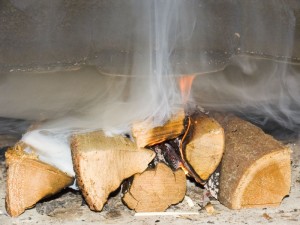Wood burning fireplaces are a great way to bring heat, warmth, and ambiance into your home. However, nothing can ruin your ability to enjoy your fireplace more than smoking issues.
When you have issues such as smoke blowing back into your home or a lingering smoky smell long after the fire has been extinguished, it can be a frustrating experience. Many homeowners simply stop using their fireplaces rather than taking the time to find and fix the root of the issue.
Instead of giving up and resigning yourself to having a fireplace for decorative purposes only, contact New Buck Chimney Services. Our expert technicians can uncover the root of your smoking issues and repair the problem, allowing you to enjoy your fireplace once again.
Smoking at the start of a fire
If your living room is flooded with smoke when you begin trying to light a fire, your problem may be a cold chimney. If you chimney is not properly insulated or was built outside of the main frame of the house, there will likely be substantial amounts of cold air in the flue, especially during the winter. This cold air has to be pushed out before the smoke can travel up the chimney, causing smoke to flow back into the room as the fire is being lit.
Homeowners can combat this by priming or warming the flue before starting the main fire. There are several ways this can be quickly and easily accomplished. After opening the damper, hold a lit roll of newspaper at the bottom of the flue. For homes with a gas pipe supplement on the bottom of the firebox, simply light the gas for a few minutes. You can also warm the flue by blowing up the flue with a hairdryer. When you feel the draft reverse – IE the cold air is no longer flowing down – you can begin lighting the fire.
Constant smoke throughout a fire
There are a number of different problems that can cause fireplaces to smoke constantly while in use. Although many of these issues involve how the chimney or firebox was built, they can often be corrected.
A fireplace opening that is too large for the size of the flue is one design flaw that could cause a fireplace to smoke. When the opening is too large, more air is pulled into the fire than the flue can remove. The height of your chimney could also result in excessive drafts, causing smoke to flow back into the room. Most building codes require that chimneys are at least two feet higher than any structures within a 10 foot radius. Second story additions, tall trees, or nearby buildings could all affect drafts in this case.
Are you using the right firewood?
The firewood that you use can affect how much smoke your fireplace produces. Making sure you use the right firewood for every fire is one way to rule this out as a cause of excessive fireplace smoking.
For minimal smoke, choose wood from hard wood trees such as birch, ash, or oak. Avoid firs, pine, and spruces as these soft woods often produce more smoke. Firewood should be cured or seasoned for at least six months in order to reduce the moisture content in the wood. The higher the moisture content of the wood, the more smoke that the fire produces.
Don’t let smoke issues stop you from using your fireplace. Contact New Buck Chimney Services today to solve your smoke problems and begin enjoying your fireplace again!

